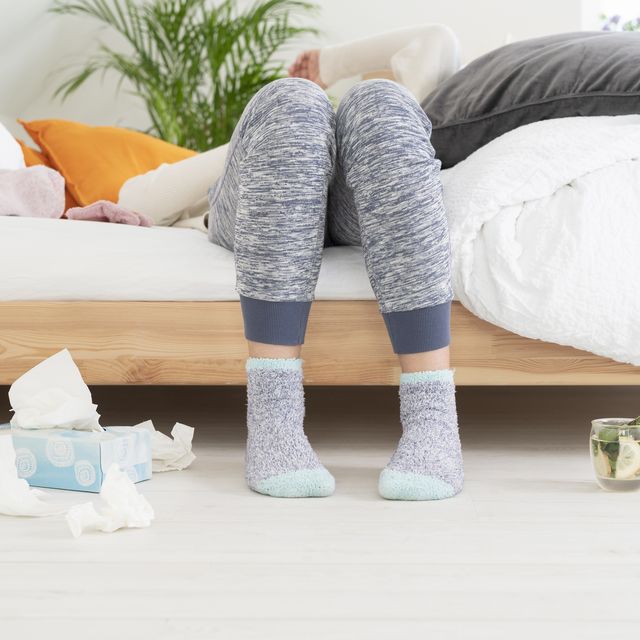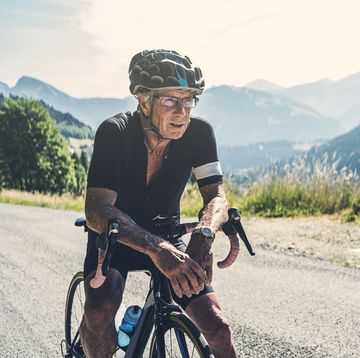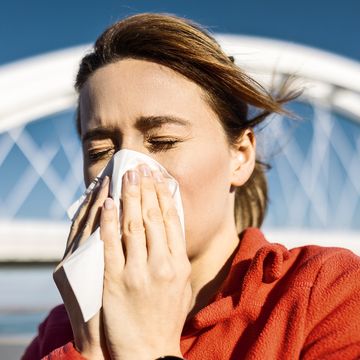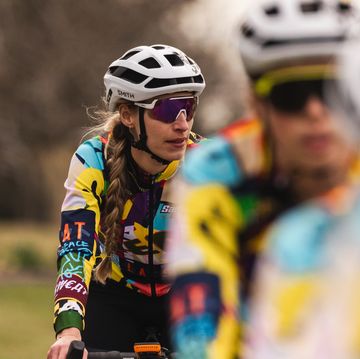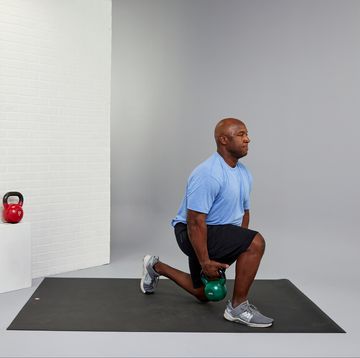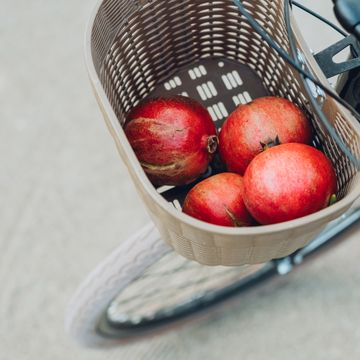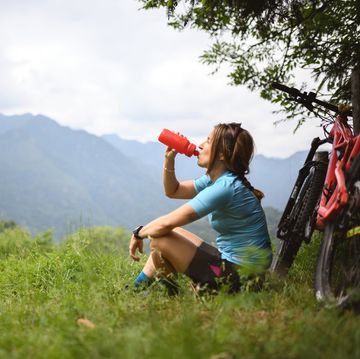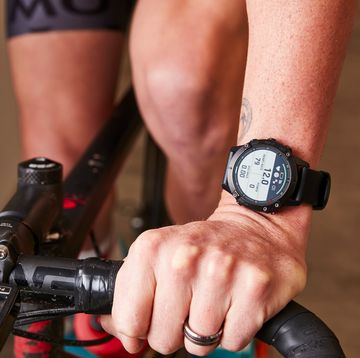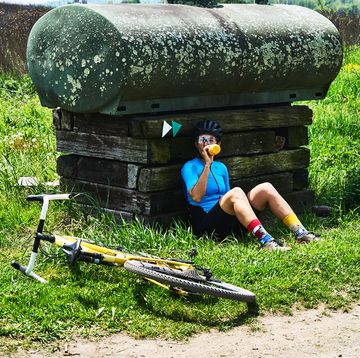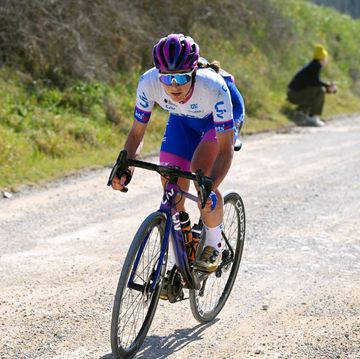It’s just about cold and flu season, with fall and winter being the worst time for illnesses—especially these days. For those living in colder climates, this is particularly true, as research shows that cold, dry conditions make it easier for viruses to linger and spread, so you’re more susceptible to every germ-y sneeze.
Of course, COVID adds a whole new layer to the possible illness mix. Past seasons, if you’d wake up with a headful of phlegm and a scratchy throat, you’d assume you have a head cold. And while it may still be just that, cold and COVID symptoms have so much overlap that it’s always a good idea to get tested. Once you know it’s nothing more than a common cold, then the question remains: to ride or not to ride?
When it comes to cycling when you’re sick, the medical guidelines are pretty straightforward. Here’s what to know before your hop on your bike with the sniffles. Plus, learn what to keep in mind with a more complicated diagnosis, like COVID.
Symptoms above the neck? Ride.
Got a runny nose, clogged head, and/or maybe a little scratchy throat? So long as you don’t have a fever (more on that in a bit), you’ve got the green light to saddle up and take a spin. Just remember: No intervals, please, as your immune system needs a little activation, not a beat-down. An easy ride will help push your white blood cells out of the lymph tissue and into circulation where they can seek out and destroy invading bacteria and viruses. It also may open your nasal passages and provide a little temporary relief from your congestion thanks to epinephrine, which is a natural decongestant.
Join Bicycling All Access for more tips and tricks
Symptoms below the neck? Rest.
If you have chest congestion, nausea, and/or a hacking cough, skip the ride and give your body some much-needed rest. Riding, even if you think you can, will just set you back, and you may spend more time recovering than if you skipped this one ride.
Symptoms everywhere? Definitely rest.
It should go without saying, but we know you (and us). If you have a fever, muscle aches, dizziness, and/or general fatigue, do your body some good and stay in bed. You’ll feel better and be back on your bike faster.
Feeling generally blah, but not terrible?
If you’re generally under the weather and feeling blah all over, your body’s number one job should be to fight infection, so you definitely want to let it do that. But you could get out and move a little with some care, says sports medicine physician Kevin Bernstein, M.D, competitive cyclist, and chief medical officer for Peaks Coaching Group.
“You could do an active recovery ride [staying in Zone 1] to keep the body moving somewhat, as long as you feel good enough to do it,” he says. “I wouldn't recommend going above that [intensity] if your symptoms are below the neck or if you are running a fever of 100.4 or greater.”
At home with COVID or a positive test?
Exercise can make COVID-19 worse. For cyclists and other active people who generally turn to physical activity to boost circulation and feel better faster when they’re a little under the weather, this is urgent news, Jordan Metzl, M.D., a sports medicine physician at Hospital for Special Surgery in New York told Bicycling while studying the relationship between exercise and COVID last year.
“COVID-19 plays by different rules when it comes to sports and exercise,” Metzl says.
As for how long you should lay low, Bernstein follows the American Medical Society for Sports Medicine’s return to play COVID guidelines that were developed for students, but apply to all of us. According to those guidelines: “No exercise is recommended for at least 14 days from diagnosis and even days after symptoms are resolved.”
It’s not wise to engage in significant physical activity during that two week period, Bernstein says. “Walking is allowed and I would even allow easy spinning on an indoor trainer. But I'm not having people wander out and about since I don't want them infecting others in a group ride,” he says.
“If someone was hospitalized or had significant illness—not asymptomatic or mild—then I’m likely going to do additional testing, including blood testing, cardiac testing, and respiratory assessment,” Bernstein adds. He suggests these tests before you jump back in the saddle.
Once you do get back, take it easy. You can find week-by-week recommendations for getting back to your regular riding routine here.
How can I prevent getting sick this season?
An ounce of prevention is worth 453 grams of cure, as they say, so here are some tried-and-true ways to avoid colds, flu, and general winter-weather crud that makes you cough, sneeze, and feel so miserable that you just can’t ride.
1. Get immunized
The flu shot and the COVID vaccine are your best protection against significant illness. “Both are very effective at preventing severe illness, death, and overwhelming the health care system resources,” Bernstein says.
2. Train smart
Some cyclists have extra protection against the invading germs that cause upper-respiratory infections like the common cold. A 2015 study published in the European Journal of Applied Physiology found that, after a 30-minute ride, a group of fit cyclists had higher levels of salivary antimicrobial proteins (sAMPs)—which play a role in warding off illness—than their less-fit peers did after the same ride. The catch: It takes consistent physical activity to ramp up those germ fighters. Another reason to keep riding through the winter.
Just remember that extreme training can dampen your immunity, says Bernstein. “Overtraining can suppress the immune system, so make sure to watch your chronic training load to prevent overtraining as this can also lead to illness,” he says.
3. Wear a gaiter
There’s a saying in traditional Chinese medicine: “Wind is the leader of the 100 diseases.” As you might have guessed, that includes the common cold. According to the same principles, our neck is particularly vulnerable to diseases of the wind, and when we let it get cold, our immunity plummets, and in comes disease. Your grandmother probably told you the same thing. Heed traditional wisdom and cover your neck with a wool-blend neck gaiter. At the very least, it will keep you toasty and comfortable while you ride.
4. Respect your sleep
Your body needs sleep to keep its immune system firing on all cylinders. Research shows that those sleeping fewer than six hours a night have dramatically lowered immune-system responses when under virus attack than those getting a solid seven to nine hours of shut-eye. When you’re already feeling under the weather, sleep helps you fight off disease-causing invaders faster and more efficiently.
5. Drink up
Dry winter air—both inside and out—can be dehydrating. Yet we often skimp on fluids during cold winter months. Don’t. You need plenty of water to produce lymph, which carries disease-fighting white blood cells throughout your body. Research also shows proper hydration is key to keeping those protective sAMP levels high. Keep a pot of hot herbal tea handy. It’ll keep you warm as well as hydrated.
6. Wash your hands
For Pete’s sake, those “wash your hands” signs are everywhere for a reason—handwashing works. Germs live on surfaces like doorknobs, cell phones, pretty much everywhere, and they stay alive longer in cold weather. You touch a surface. You touch some food or your face. You get sick. Avoid it by simply washing your hands often.

